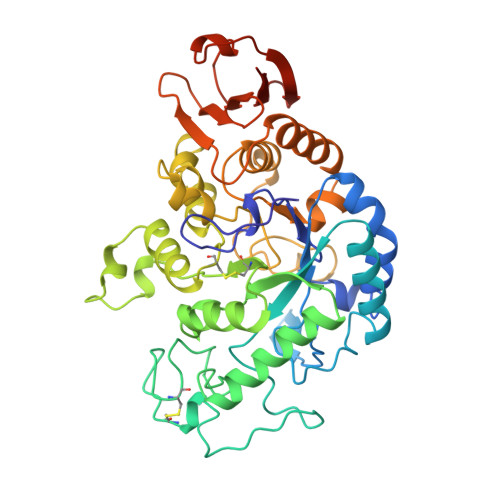Crystal structures of a mutant maltotetraose-forming exo-amylase cocrystallized with maltopentaose.
Yoshioka, Y., Hasegawa, K., Matsuura, Y., Katsube, Y., Kubota, M.(1997) J Mol Biology 271: 619-628
- PubMed: 9281429
- DOI: https://doi.org/10.1006/jmbi.1997.1222
- Primary Citation of Related Structures:
1JDA, 1JDC, 1JDD - PubMed Abstract:
The three-dimensional structures of the catalytic residue Glu219-->Gln mutant of Pseudomonas stutzeri maltotetraose-forming exo-alpha-amylase, and its complex with carbohydrate obtained by cocrystallization with maltopentaose were determined. Two crystal forms were obtained for the complexed enzyme, and a bound maltotetraose was found in each. The structures were analyzed at 2.2 A and 1.9 A resolution, respectively for the uncomplexed and complexed mutant. These structures were compared with the wild-type enzyme structure. In the complexed crystals, the maltotetraose was firmly bound, extensively interacting with the amino acid environments in the active cleft. The non-reducing end glucose unit was hydrogen bonded to the side-chain of Asp160 and the main-chain nitrogen of Gly158, which seem to be predominantly required for the recognition of the non-reducing end of the substrate that determines the exo-wise degradation of this enzyme. The reducing end glucose unit of bound maltotetraose showed clear deformation, adopting a half-chair conformation with extensive hydrogen bonds to surrounding polypeptides. The C1-atom of this deformed glucose unit lies very close to Asp193OD1 with a distance of 2.6 A. The catalytic residue Asp294 is firmly hydrogen-bonded to the O2 and O3-hydroxyl groups of the deformed reducing end glucose unit. Upon binding of the carbohydrate, small but significant induced fits were observed in the regions of Asp294, Phe156, Ile157, and Asp160. Possible roles of the three catalytic residues are also discussed.
- Institute for Protein Research, Osaka University, Osaka, Suita, 565, Japan.
Organizational Affiliation:



















